A lump in the mouth on the cheek may indicate the onset of a serious illness, or it may simply be the result of an injury. But correct diagnosis is necessary in any case, so it is better not to delay a visit to the doctor. The mucous membrane in this area is very sensitive to various damages.
Although the internal tissues are hidden, the risk of burns, food injuries, etc. increases. And due to the sensitivity of the mucous membrane, non-healing wounds, ulcers and bumps appear.
You shouldn’t immediately think about cancer; neoplasms can also be benign. Malignant ones develop much faster and cause pain. Discomfort increases significantly. But in any case, you should not make a diagnosis yourself; you need to contact a qualified specialist.
Based on the tests, the correct conclusion will be drawn and a treatment plan will be drawn up. Even if a piece of the cone is taken for examination, there is no need to panic, the doctor can take actions to rule out serious illnesses. Other reasons for the formation of lumps are numerous and also very likely.
If a lump appears on the inside of your cheek, you should immediately consult a specialist
Trauma can cause such tumors to appear. The fabrics are soft and susceptible to various types of influences. A bump on the inside of the cheek is formed due to the action defense mechanisms, the body tries to protect itself as much as possible.
In addition, the patient often has a desire to touch the ulcer with his tongue, as a result of which it only increases, and the healing process is delayed.
And the injury itself can occur as a result of damage to the edges of the teeth, due to correct installation prostheses. But against the background of changes in hormonal levels, the formation of granulomas is also possible, which is what these growths are called.
The symptoms are quite obvious. Also, the neoplasm quickly increases in volume, reaching a diameter of 2 cm or more in a short period of time, up to a week. Such a lump is painful, the patient cannot touch it, it bleeds.
The cone quickly acquires a red color, sometimes even a pronounced purple tint. Also, the neoplasm has a convex shape.
Treatment is carried out only by removal. Excision is performed in the following ways:
- surgery, during which the growth is removed. The base of the tumor is then cauterized, and electric scissors are used for the procedure. To prevent the growth of inflammation and relieve pain symptoms, antibiotics are prescribed. Although relapse is possible with poor treatment, the occurrence of granuloma-based cancer has not been recorded;
- laser removal;
- injections. Injections of alcohol directly into the growth itself are also often used;
- aletretin gel. It is used in the form of local injections.
The rehabilitation period for all procedures is almost the same. It is necessary to visit a doctor and strictly follow his instructions. It happens that a granuloma quickly reaches a significant size, but there are cases when it exists for quite a long time without causing significant inconvenience. However, her better to remove to avoid possible problems in future.
Lipoma and papilloma
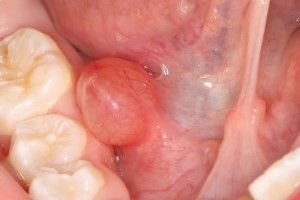
Oral papilloma
A lump inside the cheek may be a common wen. It can be determined by one characteristic. The lump moves when palpated. But the final diagnosis needs to be further verified. This growth occurs due to the accumulation of adipose tissue cells.
The reason for the appearance of such a neoplasm is a disruption of metabolic processes. Treatment is carried out only by a qualified doctor in a clinical setting. If the size of the lump is still small, drug therapy is used.
Injections of drugs are made directly into the tumor itself. A thin needle is used for this. Usually the lipoma resolves on its own under the influence of drugs, this takes about eight weeks; if this does not happen, excision is performed. Local anesthesia is used.
Papilloma is characterized by a peculiar shape. This new growth has a stalk on which the growth is attached. A single papilloma is quite rare; usually they immediately appear on the inside of the cheeks, on the palate, gums and even the tongue. But if the neoplasm is recorded in the singular, it is possible that it is a papilloma.
The patient does not experience any painful sensations; papilloma leads to discomfort only if it interferes with chewing. A person bites a papilloma, a wound is formed that bleeds, grows, and a lump may form. Large enough to be called a lump, the papilloma itself may look like it. It has a light pink tint, a rough, not smooth surface.
Such a ball in the cheek is formed due to the action of the papillomavirus. It is present in the body of almost all people. Therefore, it is extremely difficult to avoid infection. But you can prevent the appearance of external manifestations. Need to stick the right image life to strengthen the immune system. It is the weakening of the body’s protective functions that becomes the reason for the activation of the virus.
Removal occurs in two ways:
- Excision surgical instruments.
- Cryodestruction. The method is to use low temperatures. It is preferable when there are a lot of tumors, the procedure is simple, does not require long preparation and is not too painful.
You should not resort to chemicals, as such procedures can lead to degeneration into a cancerous tumor.
Atheroma and mucocele
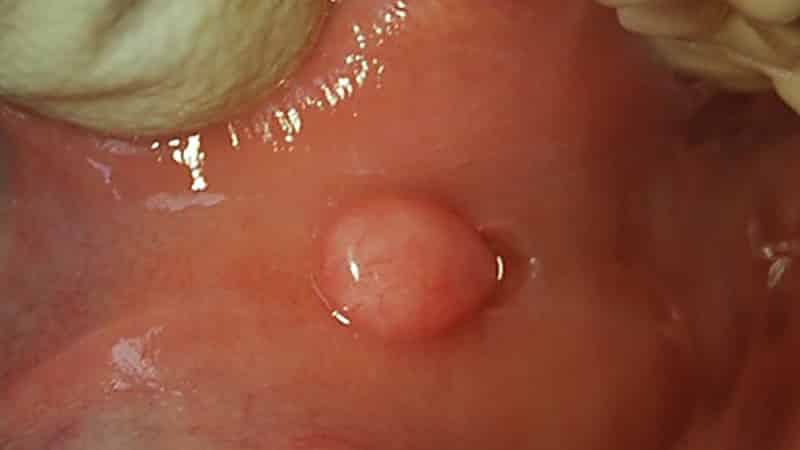
Lump on the inside of the cheek
If a ball has formed inside the cheek, it may be atheroma. This neoplasm occurs when the sebaceous glands are blocked. The secret begins to accumulate inside skin, a cyst forms that feels like a ball.
The patient does not feel pain upon palpation, and there is no discomfort when chewing. The color of the skin also does not change, although the size of the seal may be quite large, up to ten centimeters in diameter.
The negative effect in the first stages of the development of the disease is only aesthetic. But you can’t let the disease get worse, otherwise pain will occur and inflammation will begin. Due to the formation of a focus of inflammation, the general temperature body, pus begins to accumulate in the neoplasm.
Therefore, removal is necessary. It is important to remove the cyst and capsule during the operation so that there is no relapse. Other methods of excision are not used in this case. A scar may remain after the procedure.
A lump inside the cheek can be not only a wen, but also a mucocele. This is what is called a mucous cyst. It can be of considerable size, reddish or bluish in color. On palpation the patient does not complain of pain. The neoplasm is soft to the touch and filled with fluid. The mechanism of occurrence is as follows: a person constantly bites his cheek, which is why microtraumas appear. Or the salivary gland is damaged and such a growth occurs. Most often, a cyst forms in young people.
It is necessary to remove the growth, because over time it can cause inflammation., spread of infection throughout the body. Excision is performed only surgically. The damaged gland is removed, as well as the growth itself. The wound must be sutured. Subsequently, the patient visits a doctor to monitor the condition. A repeat procedure may be required if the entire contents of the cyst were not removed at once, that is, in case of relapse.

A tumor on the inside of the cheek in some cases may indicate the occurrence of a cancerous tumor
The patient is advised to eat only soft food and not to injure the area of the procedure. The doctor may apply a bandage. Most often, the wound heals quite quickly, without causing additional problems. But you should be careful during the first time after surgery. Otherwise, the seams may come apart and additional intervention will be required.
Sores on the lips can cause scars that may require surgery to remove. cosmetic procedures. Such scars themselves may look like balls or bumps, depending on the size of the wound and how healing occurred. Compliance with a certain regime is mandatory. Any surgical intervention is tolerated by the body depending on the strength of the immune system.. Therefore, it needs to be strengthened, adhere to the right diet, and eliminate harmful effects.
In some cases, a neoplasm may indicate the occurrence of a cancerous tumor. Most often, malignant growths appear on the inside, under the jaw or near the ear. This means the appearance of salivary gland cancer. This is a serious disease. But you need to accurately establish its presence and carry out the correct diagnosis.
With salivary gland cancer, numbness is also recorded when the face is squeezed.
Pain is not necessary at the first stage. But when the branch of the trigeminal nerve is compressed, discomfort is felt and the pain intensifies. The pain may radiate to the tonsils.
Diagnosis is made using a biopsy. Tissue samples are taken for examination. If diagnosis is made in the early stages, then it is easier to influence cancer cells and treatment is more effective. Computed tomography is also used for diagnosis. If a tumor appears, you should consult a doctor, even if it does not cause discomfort.
The susceptibility of the mucous membrane in this area is high, so a bump on the cheek can be the result of injury, but sometimes it is also a sign of a serious illness. It is necessary to seek professional diagnostics in any case, because over time, a benign formation can acquire a completely different character. Among other things, the patient begins to feel difficulties while eating and in everyday communication; the lump or papilloma tends to increase in size over time.
Often a bump inside the cheek appears as a result of some kind of injury; this reaction is protective in nature and completely normal. It is not recommended to touch the tumor to allow the wounds to heal properly.
Another reason is the occurrence of granulomas against the background of changes in hormonal levels. But incorrect installation of dentures can also cause damage; the edges of the teeth begin to touch the soft tissues in the mouth, and the mucous membrane does not have time to recover.
Typically, such a formation is characterized by a high growth rate - in a week it can develop up to 2 cm in diameter, sometimes more. Additional unpleasant symptoms - the lump causes pain, begins to bleed, takes on a convex shape, and the color of the mucous membrane changes from bright red to a distinct purple hue.
What can you do
After a biopsy, you may be prescribed the following types treatment:
- Surgical. To do this, electric scissors are used, and after removing the tumor, the area is cauterized. Therapy continues in the form of a course of antibiotics;
- Injection. These are special injections containing alcohol, which are given directly to the area of the granuloma;
- Laser;
- Local injections of aletretin gel.
Regardless of the size of the growth, do not delay visiting a specialist, this way you will feel comfortable faster and avoid possible complications.
Lipoma
This is a soft lump, otherwise called a wen, since it is formed from adipose tissue cells. It occurs when metabolic processes in the body are disrupted, is often small in size, and does not cause any particular inconvenience. If the size of the wen is insignificant, drug therapy is prescribed - a special drug is administered. When reaching at least 3 cm, surgical excision is required under local anesthesia.
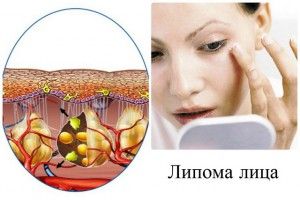
Atheroma
When the sebaceous ducts are blocked, the secretion begins to accumulate under the skin, a lump appears - a round and colorless compaction with a diameter of 1 to 10 cm. If you palpate, you can detect the mobility of the atheroma, there is no pain.
This tumor requires careful study and treatment, since in advanced cases side effects occur: pain, accumulation of pus, inflammation, increased body temperature.
Even if at first you do not feel any particular discomfort, other than a violation of aesthetics, it is highly not recommended to delay treatment. A surgical operation is prescribed - excision of the lump along with the capsule, and there is a possibility of scarring of the operated area.
Mucocele
This is the name given to a cyst that occurs in the mouth on the mucous membrane of the cheeks and lips. It is characterized by a bluish color, without pain; upon palpation, the homogeneity of the structure is felt. There is also a white, cloudy liquid inside; sometimes the opening occurs spontaneously, otherwise the bubble must be excised.
The probable causes are trauma to the salivary glands, constant biting of an area of the mucous membrane, most often young people suffer from this.
Salivary gland cancer
With this disease, a lump appears in the mouth (near the ear, under the jaw, on the inside of the cheek), the nature of the formation is malignant. As a result, compression of the trigeminal nerve branch occurs, the patient may feel numbness in certain parts of the face, muscle tone deteriorates, and pain occurs in the tonsil area.
In addition to the biopsy, it is necessary to carry out diagnosis using computed tomography, and based on the results, the specialist prescribes therapy.
Papilloma
This growth, which occurs with inside cheeks, looks like a bump on a leg. It is soft in structure, usually pale pink in color, looks like a wart, has a rough surface and does not cause pain. The formation can be single, but sometimes it covers a significant area, localization - tongue, larynx, cheeks, gums, palate.
As a result of the constant interaction of the papilloma with various irritants, especially during meals, it becomes injured. Then, when a wound occurs, bacteria begin to accumulate in the affected area, causing inflammation. Human papillomavirus, which is the source of the above-mentioned neoplasm, if your immunity is strong, may never make itself known, and when the body’s defenses are weakened, the probability increases sharply.
For removal, a surgical method or exposure to neoplasms using liquid nitrogen is used. The use of chemicals is not recommended, as this can lead to the degeneration of the tumor into a malignant form.
How does infection occur?
Papilloma is one of the most common diseases that causes neoplasms, not only in adults, but also in children and adolescents undergoing complex hormonal changes. Most often this happens for the following reasons:
- Sharing utensils or personal hygiene items with a virus carrier;
- Kissing a carrier of papillomavirus, if it is localized in the oral cavity;
- Oral sex without the necessary protection;
- If the mother is a carrier of the virus, there is still a possibility of transferring it to the child.
The appearance of papillomas in the mouth is influenced by numerous factors that reduce the body’s immunity:
- Various bad habits;
- Hormonal imbalances;
- Infectious diseases, colds;
- Chronic inflammation;
- Pregnancy;
- Physical and mental fatigue;
- Long-term use of antibiotics;
- Diseases of the gastrointestinal tract.
These circumstances only increase the risk of papillomas, but this is completely unnecessary.
Localization
Papillomas manifest themselves differently depending on their location, so indirectly you can understand where exactly the localization is present. Let's consider several options:
| Larynx. | The signs are as follows - difficulty breathing, hoarseness in the voice, slight difficulties with diction. If not treated in a timely manner, papillomas can grow on the mucous membrane of the upper respiratory tract. |
| Tonsils. | Diagnosis is usually difficult; there is a possibility of confusing the disease with bacterial laryngitis, the consequences of a cold. There is swelling vocal cords, feeling foreign object in the throat, hoarseness, difficulty breathing, eating. |
| Language. | Usually flat or pointed formations appear here, the latter cause significant inconvenience - due to regular trauma, bleeding and ulcers occur. |
Professional help
In order to simultaneously carry out preventive measures for patients suffering from manifestations of papillomavirus, the mouth must be sanitized. Needs to be fixed inflammatory processes, as well as caries, plaque and tartar.
After preliminary measures, foci of the disease are treated using antiviral ointments and gels. Next, vitamin-mineral complexes and, if necessary, immunomodulatory drugs are prescribed.
If drug treatment not enough, you have to resort to surgical techniques. Two methods are used - laser and radio wave removal; in the latter case, it is convenient to take part of the material for histological examination.
How to behave after surgery
After excision of the affected area in the mouth, the patient must be very careful about his condition. For example, you need to reconsider your diet and exclude any rough food from it. At first, if a bandage has been applied, you should be extremely careful not to touch the stitches, you need to let them tighten properly. In addition, when areas on the lip are excised, there is still a risk of scarring.
We must not forget that the operation itself is additional stress for the body; after it, it is important to strengthen your strength from the inside. This requires proper nutrition, good dream, refusal bad habits, if possible, avoid any excitement.
Home therapy

At home, you can start therapy in case of isolated manifestations, when the tendency to increase the size of the papilloma does not persist. Here are a few recipes to help you cope with the disease yourself:
- If the manifestations are very fresh, try using raw protein chicken egg several times a day;
- Take a small piece of cotton wool, soak it in castor oil and apply it to the affected area. Repeat the procedure twice a day;
- Cut a clove of garlic into slices, lubricate the growths with them two to three times a day;
- Prepare a tincture - you will need green peel or leaves walnut. It is necessary to pour the dry ingredient with alcohol and let it sit for two weeks, then lubricate it with the forming agent once or twice a day.
The appearance of a bump on the cheek can be caused by simple reasons or be a sign of a serious illness. If the lump does not go away, you should consult a doctor. Usually, an examination is sufficient to diagnose the disease, but if necessary, the doctor prescribes an x-ray, angiography, or a biopsy. A lump or ulcer can cause inflammation of the mucous membrane, as they are susceptible to mechanical damage.
Types of tumors on the inside of the cheek with photos
Typically, compaction formation begins with mechanical damage. The appearance of a tumor on the inside of the cheek is caused by a number of reasons:
The most common viral infection leading to the formation of compacted tissue is human papillomavirus. In children, tumors may be a consequence of impaired tissue differentiation during the prenatal period.
- Seals consisting of epithelial cells are called epithelial. The most common are papillomas, nevi and Serra glands.
- The proliferation of connective tissues leads to the formation of fibromas, myomas, myxomas, pyogenic granulomas, epulises and neuromas. Compacted tissue is formed from cells of the mucous membrane, muscle tissue, and the sheath of nerve fibers.
- Tumors of vascular origin are represented by hemangiomas and lymphogiomas. This type of tumor is soft and shrinks in size when pressed.
Causes of compaction
Dense ball on inner surface mucous membrane is often a consequence of inflammation, the process is caused by dental reasons. Redness and swelling occur after tooth extraction, during the eruption of wisdom teeth, or as a result of gum disease.
An infection that affects the root of a tooth with insufficient treatment leads to the formation of a focus of inflammation in the pulp chamber. The development of infection occurs more actively in a weakened body.
papillomavirus
The growth caused by papillomavirus is attached to the mucous membrane with a stalk. First, one or several papillomas appear, scattered across the palate, gums, tongue, and the inside of the cheeks. However, the protruding papilloma often bites, resulting in a bleeding wound. The papilloma grows, turning into a lump.
The lump that grows from the papilloma is surgically removed. Use to eliminate it chemicals not recommended, as this can lead to the degeneration of the tumor into a malignant form.
Cyst or injury to the sebaceous gland
A swelling can form in the mouth from the inside when the sebaceous gland is blocked. The result will be the accumulation of gland secretion in the duct, its swelling, and the formation of a capsule. The cyst is painless on palpation and resembles a ball.
 Despite the significant size that the cyst can reach, the skin color does not change; discomfort depends on the size of the formation. The cyst must be removed; there is another reason for this, besides aesthetics. The capsule with sebaceous secretion becomes easily inflamed. Inflammation is accompanied by pain, fever, and the formation of pus. Excision of the cyst is necessary to remove the capsule. A well-performed operation will prevent further growth of the cyst and the formation of a focus of inflammation.
Despite the significant size that the cyst can reach, the skin color does not change; discomfort depends on the size of the formation. The cyst must be removed; there is another reason for this, besides aesthetics. The capsule with sebaceous secretion becomes easily inflamed. Inflammation is accompanied by pain, fever, and the formation of pus. Excision of the cyst is necessary to remove the capsule. A well-performed operation will prevent further growth of the cyst and the formation of a focus of inflammation.
If a growth appears inside the mouth, the cause could be frequent injury to the salivary gland. Secretion accumulates inside such a cyst. The growth is soft to the touch and does not cause pain, but it must be removed surgically. Like a sebaceous cyst, it can cause purulent inflammation.
The growth also requires attention because this is how cancer manifests itself at the initial stage. It is impossible to recognize the symptoms of salivary gland cancer on your own. At the first stage there may be no pain. The exception is when the branches of the trigeminal nerve are compressed. The patient experiences discomfort, pain gradually intensifies, radiating to the tonsils. Diagnosis is carried out by a doctor, the main research method is a biopsy (tissue samples are removed from the patient and tested for the presence of cancer cells). The effectiveness of treatment depends on the time of detection of the disease.
Other reasons

Diagnosis of the disease
If foreign formations appear in your mouth, you should contact your dentist. He will examine the oral mucosa and refer the patient to a doctor who can identify and treat the disease. Some types of growths are treated by a dermatologist or otolaryngologist.
Diagnostics, except visual inspection, includes radiography, computed tomography or magnetic resonance imaging, biopsy with tissue sent for histological examination. Appointment possible ultrasound examination, angiography.
Treatment of a bump on the cheek
Any neoplasm on the cheek from the inside interferes with chewing and is constantly injured. The patient is indicated for surgical treatment to relieve discomfort and prevent cancer. Removal is carried out in several ways:
- cryodestruction – destruction of neoplasms using low temperatures (liquid nitrogen);
- sclerotherapy - the introduction of a drug into the vessel that causes the walls to stick together and then resolve;
- laser – layer-by-layer removal of the cyst and its contents with a laser scalpel;
- radio wave method - removal of high-frequency radio waves by a beam;
- surgical excision with a scalpel.
If the cause of the tumor was a viral infection, surgical methods are supplemented with antiviral drug therapy. Sometimes they help folk remedies, but they cannot cope with the cause of the disease.
Medicines
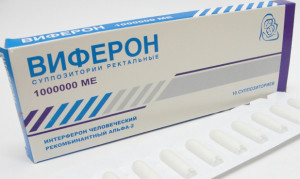 The development of a tumor on the mucous membrane, which is viral in nature, is treated with interferon-based drugs. They help the body cope with the disease and have a general strengthening effect.
The development of a tumor on the mucous membrane, which is viral in nature, is treated with interferon-based drugs. They help the body cope with the disease and have a general strengthening effect.
- These drugs include: Viferon, Intron, Altevir, Roferon.
- Taking vitamins is indicated, antiviral treatment is carried out with Lavomax, Cycloferon and others.
- To stop tumor growth, cytostatics may be prescribed.
Compresses
Hot and cold compresses cannot be used to treat growths: they can worsen the situation and contribute to the exacerbation of the disease. For home remedies, you can try applications with castor oil; it is recommended to repeat them twice a day. It is also suggested to wipe the growth with a cut clove of garlic, but in the case of an ulcer or erosion, such treatment is more likely to harm.
Rinse
Rinsing is useful only at the initial stage, after biting or the appearance of a small dense area.
- A decoction of oak bark will help you cope with inflammation and defeat infection. You should rinse your mouth at least 7 times a day for a week.
- Pine needles will also help. They need to be crushed, steamed in a thermos and used after brushing your teeth.
Preventive measures
Prevention of the formation of ulcers, growths, and inflammations in the mouth consists of quitting smoking, limiting alcohol intake, proper nutrition. You should not stay in the sun for long periods of time in the summer.
Oral hygiene and timely visits to the dentist play an important role. The appearance of wounds or erosions requires immediate measures to prevent infection.
The appearance of sores in the mouth of various origins meets all the time. Whether you burned yourself with tea or bit your cheek while eating, you cannot avoid a wound. But if there is not a small wound in the mouth, the cause of which you know, but a whole bump on the cheek, then you should consult a doctor as soon as possible.
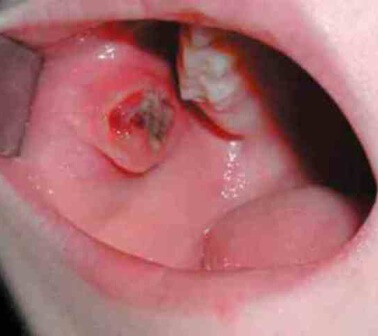
A growth on the cheek is divided into benign and malignant. But even a benign tumor, if left untreated or treated incorrectly, can develop into a malignant tumor.
Types of growths and methods of their treatment
Exists a large number of growths in the mouth, including growths on the roof of the mouth. The reasons for their appearance and methods of treatment are varied. The most common of them:

All of the above growths in the mouth are benign tumors. But cancer of the salivary gland is already a malignant formation. The growth occurs on the inside of the cheek, between the jaw and ear.

It manifests itself in the form of weakness of the muscles of the side on which it formed. To make a correct diagnosis, computed tomography is used and tissue is taken for biopsy. Based on the results obtained, the doctor prescribes appropriate treatment.
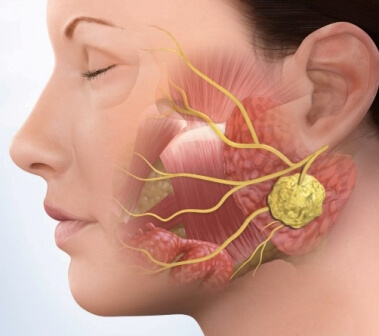
But don't panic if you feel it on your cheek blood bladder. It doesn't contain anything dangerous. Most likely, it appeared as a result of biting the cheek with teeth while eating or from cracking seeds for a long time. So, small blood bubbles that can cause slight discomfort in the oral cavity are simply a protective reaction of the body.

They go away on their own within 3 days. If after this period the bubble in the mouth does not go away, then it is better to see a dentist to rule out other diagnoses. In the meantime, you can rinse your mouth with a decoction of medicinal herbs, for example, a decoction of oak or chamomile, which has an anti-inflammatory effect. Rinsing your mouth with an antiseptic will help relieve the painful condition of growths on the cheek. Good antiseptics are chlorhexedine and furatsilin.
Mucous membrane oral cavity Quite soft fabric. Injuries, burns, and bacteria can easily cause wounds and ulcers. A lump that appears inside the cheek can be a symptom of a serious illness, so you should consult a doctor as soon as possible.
Growths can be benign or malignant. Cancerous tumors grow much faster and cause discomfort and pain. Some benign tumors can develop into malignant ones. Whether or not the growth is cancerous is determined after a biopsy. The doctor plucks off a piece of the lump and sends it for analysis to identify cancer cells.
A lump in the mouth on the gum or cheek may appear as a result of injury. Damage is caused by sharp edges of teeth, incorrectly installed dentures, and mechanical injuries. A benign growth is formed - a granuloma. The cause is also hormonal imbalance and retinol treatment. The disease is characterized by rapid growth (up to 2 cm in diameter). The cone is convex, dark red or purple, painful, bleeds on palpation.
Granuloma is removed in the following ways:
- Surgical excision with electric scissors, cauterization of the base. Antibiotics are prescribed. The disease can recur if treated poorly.
- Laser therapy.
- Alcohol injections into the lump.
- Local applications of aletretinoin gel.
No transformation of the granuloma into a cancerous tumor was observed.
If a soft lump appears on your cheek and moves when palpated, it may be a lipoma (fat). A new formation of adipose tissue cells is formed. The lump does not hurt, grows slowly, and may be visible or detectable only when touched. The cause of the disease is a violation of metabolic processes in the body.
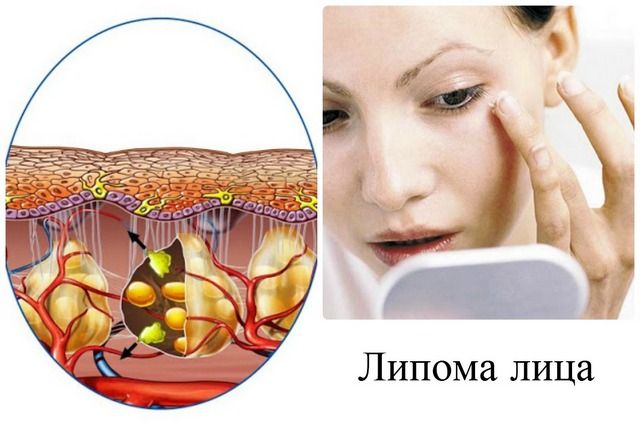 Lipoma is treated in two ways:
Lipoma is treated in two ways:
- Drug therapy. The lump is pierced with a thin needle and medications are injected. The fatty tissue gradually resolves over 2 months.
- If the lipoma is 3 cm or larger in size, it is removed surgically. The lump is excised under local anesthesia.
A formation on the inside of the cheek that looks like a bump on a stalk is called a papilloma. The growth can be isolated or affect parts of the palate, gums, cheeks, tongue, and larynx. The lump is soft, absolutely painless, with a rough surface, pale pink in color. It interferes with a person's chewing of food. It is constantly bitten, thereby forming a wound where bacteria can accumulate and cause inflammation.
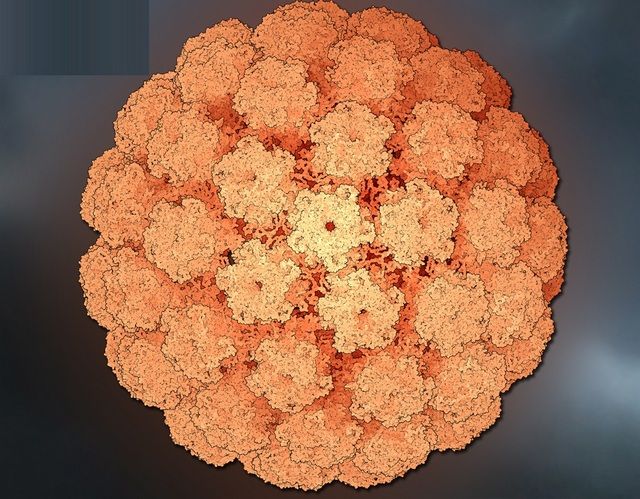 The disease is provoked by human papillomavirus, which infects 90% of the world's population. With strong immunity, the virus does not manifest itself in any way, but with favorable conditions affects the mucous membranes of the body with characteristic formations.
The disease is provoked by human papillomavirus, which infects 90% of the world's population. With strong immunity, the virus does not manifest itself in any way, but with favorable conditions affects the mucous membranes of the body with characteristic formations.
Methods for removing papilloma:
- Cryodestruction – removal with liquid nitrogen. The growth is affected by very low temperatures.
- Surgical removal.
Exposure of papilloma to chemicals can lead to its degeneration into a malignant form.
 The formation of a lump on the cheek on the outside can be caused by a sebaceous gland cyst - atheroma. When the gland ducts are blocked, the secretion accumulates under the skin. The formation looks like a colorless round compaction, reaching from 1 to 7 cm in diameter. On palpation, the atheroma is painless and mobile.
The formation of a lump on the cheek on the outside can be caused by a sebaceous gland cyst - atheroma. When the gland ducts are blocked, the secretion accumulates under the skin. The formation looks like a colorless round compaction, reaching from 1 to 7 cm in diameter. On palpation, the atheroma is painless and mobile.
When the disease is advanced, the lump becomes inflamed, hurts, purulent masses accumulate inside, and the temperature rises.
It is surgically excised together with the capsule. A scar may remain after the procedure.
A bubble located on the inside of the cheeks and lips is called a mucocele or mucocele  cyst. The formation is bluish in color, filled with liquid, soft and painless on palpation. If it opens spontaneously, a cloudy liquid may leak out. A cyst occurs due to constant biting of an area of the mucous membrane, injury to the salivary glands. Most often, young people suffer from the disease.
cyst. The formation is bluish in color, filled with liquid, soft and painless on palpation. If it opens spontaneously, a cloudy liquid may leak out. A cyst occurs due to constant biting of an area of the mucous membrane, injury to the salivary glands. Most often, young people suffer from the disease.
During treatment, the bladder is excised, followed by isolation of the affected gland. The edges of the wound are sutured.
Salivary gland cancer
A malignant tumor on the cheek, the first symptom of which is the appearance of a lump on the inside of the cheek, under the jaw, near the ear, is called salivary gland cancer. Additionally, numbness of a part of the face occurs due to compression of the branch of the trigeminal nerve, muscle weakness appears on the affected side, and pain in the tonsil area.
To make a correct diagnosis, a computed tomography scan is performed and tissue is taken for biopsy. Based on the examination results, the doctor determines the stage of the disease and selects treatment methods.





